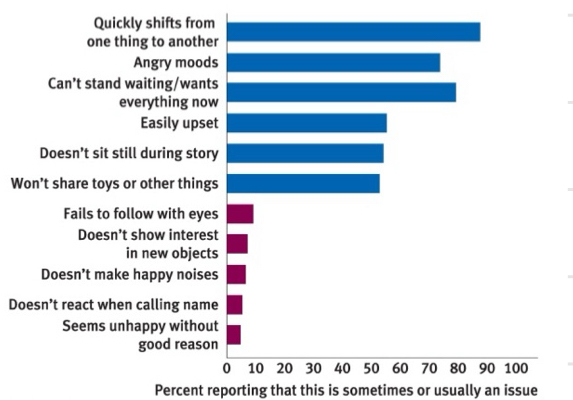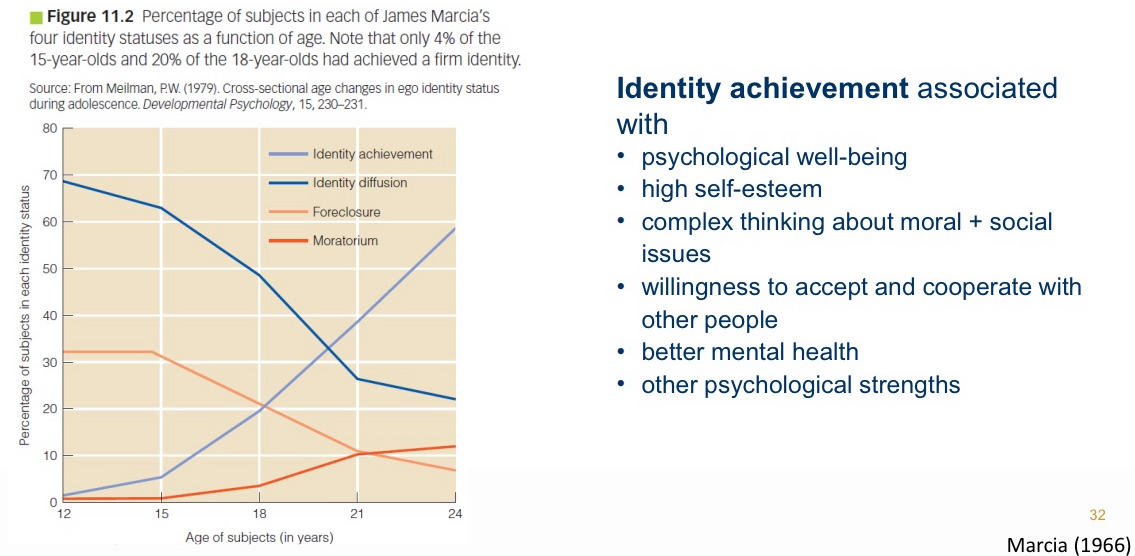developmental psychology ch12
1/40
Earn XP
Description and Tags
Name | Mastery | Learn | Test | Matching | Spaced |
|---|
No study sessions yet.
41 Terms
What is temperament?
Inborn behavioural tendencies showing how individuals typically respond to the world.
Thomas & Chess’s Three Temperament Types (1977) - Based on parent-child interactions.
Easy (40%): Happy, regular habits, easily soothed.
Slow to warm up (15%): Needs time to adjust to new situations.
Difficult (10%): Irritable, irregular routines, intense reactions.
Continuity of temperament and personality:
Continuity in childhood:
Difficult temperament (versus easy) in infancy predicts difficult temperament in childhood.
Higher risk of behavioural problems (e.g., temper tantrum).
Discontinuity in adulthood:
Adulthood adjustment little to do with temperament during infancy.
Some temperament dimensions relate to later Big Five personality traits.
But individual differences (due to influence of environment!):
Easy children can also develop behaviour problems
• Difficult children do not always develop behaviour problems
Rothbart’s Temperament Dimensions
Infants’ reactivity to experiences + their capacity for self regulation → Temperament:
Surgency/Extraversion: Energetic, positive, seeks stimulation.
Negative Affectivity: Sadness, frustration, fearfulness.
Effortful Control: Ability to shift/focus attention, inhibit responses (emerges in toddlerhood).
When do the temperament dimensions emerge?
Surgency/Extraversion & Negative Affectivity: Infancy
Effortful Control: Toddlerhood/early childhood till adolescence
Temperament: How to measure it?
Design situations tailored to elicit joy, fear anger
Observe how toddlers act
Exuberance: entertaining with puppets: measure laughter/reservation
Fear-eliciting condition: child enters the room filled with scary toys
Anger-eliciting condition: restrain child in car seat and rate frustration.
Temperament as Risk Factor: Shy Children
Positives: Early signs of conscience.
Negatives: Risk for social withdrawal, internalising problems.
Advice: Refrain from overprotection
Temperament as Risk Factor: Exuberant temperament
Happy, disinhibited, fearless in new situations and with new people:
Joyous, fearless, outgoing, adventurous
Potential problems with conscience development; at higher risk for later “acting-out” behaviour problems
Later development: Risk for externalising problems
Parental advice:
No use of “power assertion”
Sensitive positive parenting and love
Calm reasoning when whining
Time-outs for defiant behaviour (questioned)
What is normal?

What is “Goodness of Fit”?
Compatibility between a child’s temperament and the parenting environment.
Early childhood:
Child learns to do more by him/herself.
Testing/crossing boundaries: “Terrible two”
1 in 3 parents labeled their kid as having behavioural problems, but outbursts are normal.
Individual differences in self-regulation!
Differences in toddler self-control have genetic roots (temperamental traits).
Which child had internalised mother’s rules?
Room with toys, two conditions: “Clean them up” vs “don’t play with them” - Mother leaves:
Improvement from age 2 to 4
“Cleaning up” more challenging than “not playing” with toys
Fearful inhibited children more obedient
Girls listened better
Stability over time (1 → 4 years)
Marshmallow test:
Tests delay of gratification - “you can eat one now” or “you can wait and then get two”
Kids who did better tend to do better in school/BMI, results not replicated with a more diverse/larger sample
SES matters
What are self-conscious emotions?
Emotions requiring a sense of self (e.g., guilt, shame, pride). Appear around age 2-4.
Important fro socialisation: less unwanted behaviour, more self regulation
Typical emotions in Year 1 and Year 2:
Year 1: Basic emotions (joy, fear, anger)
Year 2: Complex emotions (shame, guilt)
Marshmallow Test & Implications
Linked to future self-control and academic success; however, SES influences results more than pure willpower.
Do individual adults retain their ranking on trait dimensions compared with others in a group over years?
Consistency in rankings within a group:
High correlations between scores on same trait dimensions at different ages.
Consistency increases with age:
Not much change with age after around 50
Developing Personality:
Some temperament dimensions relate to Big Five personality traits:
Surgency/extraversion → extraversion, negative affectivity → neuroticism, effortful control → conscientiousness
Effortful-control dimension of temperament → Self-control or self-regulation in childhood
→ Conscientiousness later in life: good developmental outcomesPersonalities change in response to parenting, cultural pressures, and life events
correlations between early childhood traits and adult traits usually quite small
children's traits in elementary school years begin to predict adolescent and adult
personality
some aspects of personality stabilize only in adolescence or even adulthood
> Roots of adult personality in childhood, but full personality formation takes many years.

Maturity Principle of Personality Development
People become more emotionally stable (↓neuroticism), agreeable, and conscientious with age.
When do major personality shifts occur?
Mostly between adolescence and middle adulthood.
Does personality change in late adulthood?
Little systematic change; more influenced by life events than age.
Development of Self-Concept: Self-concept in infancy
Begins with implicit sense of self (agency, bodily awareness).
2–3 months: Awareness of body as distinct from environment.
Development of Self-Concept: Self-recognition milestone
Around 18 months: visual recognition in mirrors - Rouge test.
18–24 months: Begin using self-referential language.
Development of Self-Concept: Self-concept in preschool years
Concrete, physical traits (e.g., “I am big,” “I have a red shirt”).
Development of Self-Concept: Self-concept in middle childhood
Becomes more abstract, psychological (e.g., “I am smart,” “I’m funny”). Also enduring qualities, part of social group and social comparison.
Development of Self-Concept: Self-concept in adolescence
More differentiated and integrated.
Includes social roles and group memberships.
Involves reflection and identity exploration.
What is identity?
A coherent sense of self including beliefs, values, and direction in life - integrations of self-perceptions into a coherent self - who you are.
Identity formation - classification into one of four identity statues based on progress toward an identity in each of several domains.
Erikson’s Psychosocial Stage: Identity vs Role Confusion
Adolescence is key period for identity formation.
Failure leads to confusion and instability.
What influences identity formation?
Cognitive development (formal-operational thinking)
Personality (openness, conscientiousness)
Parental relationships (authoritative parenting)
Opportunities to explore (e.g., education)
Culture (individualistic vs collectivistic norms)

Marcia’s Four Identity Statuses
Identity Diffusion:
No crisis, no commitment. Avoidance, lack of direction.
Identity Foreclosure:
Commitment without prior exploration (e.g., adopting parents’ values unquestioningly).
Identity Moratorium:
Ongoing exploration without commitment. Often experienced in adolescence.
Identity Achievement:
Commitment after exploration. Most stable and healthy outcome.
How does culture influence self-concept and identity?
Individualistic cultures: Emphasise personal traits.
Collectivistic cultures: Emphasise group roles and harmony.
Role of peer influence in adolescence:
Peers become central in shaping identity, values, and self esteem.
What is the impact of social comparison?
Becomes prominent in middle childhood and adolescence; shapes self-esteem and identity.
How does gender identity develop?
Emerges in early childhood
Solidifies in middle childhood/adolescence through cultural and peer input.
What is gender intensification?
Increased adherence to gender roles during adolescence
More common in girls
What is self-esteem?
Global evaluation of one’s worth and value.
Developmental trajectory of self-esteem:
High in preschool
Declines in early school years
Stabilises or increases in adolescence/early adulthood (esp. with positive experiences)
What influences self-esteem?
Parenting style (warmth + structure)
Peer relationships
Achievements
Body image (especially in adolescence)
How does personality continue in late adulthood?
Stability overall, but changes due to health, losses, and life reflections may occur.
What is narrative identity?
Internalised life story that helps make sense of one’s past and direction.
Positive aging and personality:
Older adults may experience increased agreeableness and emotional regulation (less neuroticism).